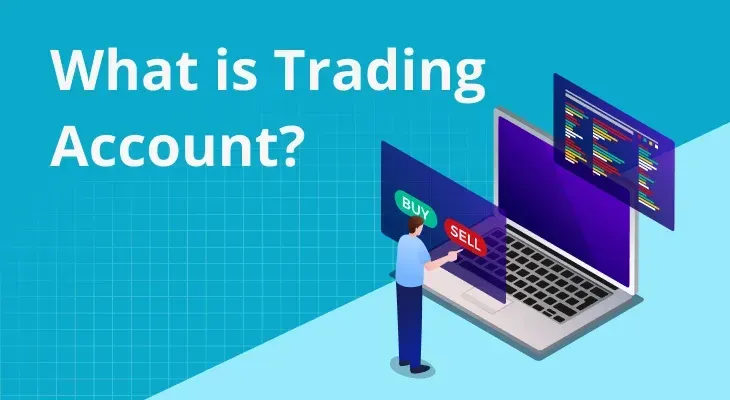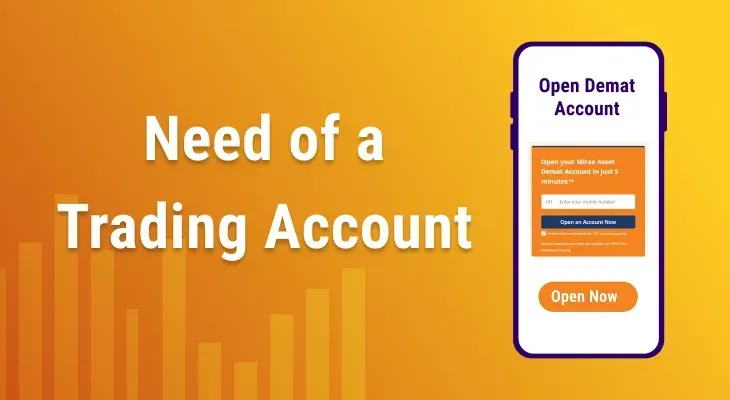
Table of content
- What is a trading account?
- Importance of trading account
- Types of Trading Accounts
- How does a trading account work?
- Features and benefits of a trading account
- Features of Trading Account:
- Benefits of Trading Account
- What is the Eligibility criteria to open a Trading Account
- Documents required to open a Trading Account
- Process of opening a trading account online on m.Stock
Trading Account: Meaning, Feature, Types & Benefits
What is a trading account?
A trading account, along with a demat account, is one of the prerequisites for buying and selling stocks. Trading account was preceded by the public outcry system in the 1980s where brokers used to call out the bids on the trading floor. However, with the advent of the electronic trading system in the mid-1990s, buying and selling of stocks has been done solely through online accounts.
Investors need to open a trading account with a SEBI-registered broker, such as m.Stock, which acts as an intermediary to conduct trades on investors’ behalf. A trading account is different from a demat account, which is used to store the shares purchased on the stock market. Brokers open demat accounts with a depository such as CDSL or NSDL on behalf of investors.
Importance of trading account
A trading account is a must to enable you to invest in different securities such as stocks, bonds, ETFs, currencies and so on. A trading account also gives you access to many technical analysis tools and charts, which help you make smarter investment decisions.
Furthermore, with technological advancement, trading accounts have substantially increased the speed and volume of orders that can be placed on the exchanges. This helps investors save time and trade more efficiently.
Read Also: Importance of Trading Account and Why Do You Need it
Types of Trading Accounts
There are several types of trading accounts to choose from. By understanding these different types of trading accounts, you can opt for the one that best fits your trading style and investment goals.
Equity Trading Account:
An equity trading account is mainly for buying and selling shares, including futures and options. However, this type of account is not suitable for activities such as trading in commodities or taking delivery of stocks.
Commodity Trading Account:
A commodity trading account is designed for trading in commodities like oil, metals, and agricultural products such as coffee. This account is ideal for those looking to trade in securities beyond the equity market.
Online And Offline Trading Accounts
Trading accounts can be classified based on how orders are placed:
Online Trading Accounts: Orders are placed through mobile apps and/or internet platforms, providing convenience and speed. This type of trading account is largely paperless and well suited for tech-savvy people.
Offline Trading Accounts: Orders are placed over the phone, allowing those who prefer personal interaction or do not have reliable internet access to trade. This is suitable for people not comfortable using online platforms.
Two-In-One And Three-In-One Trading Accounts
Two-in-One Accounts: These accounts combine a trading account with a demat account, facilitating easy trading and holding of securities.
Three-in-One Accounts: These accounts integrate a trading account, demat account, and a savings bank account, allowing seamless transfer of funds and shares, making the trading and investment process more efficient.
Discount And Full-Service Trading Accounts
Discount Trading Accounts: These accounts offer basic trading services at lower costs. They are suitable for self-directed investors who do not need additional services like research, stock recommendations, and those who are proficient in trading in securities.
Full-Service Trading Accounts: These accounts provide a range of additional services, including research reports, stock recommendations, and personalised advice, catering to investors who seek professional guidance.
All-In-One Accounts:
All-in-one accounts offer a comprehensive solution, allowing investors to trade in stocks, commodities, mutual funds, systematic investment plans (SIPs), bonds, Gold ETFs, and even participate in IPOs. These accounts provide a one-stop-shop for diverse investment needs, ensuring convenience and broad market access.
How does a trading account work?
Trading account is directly linked to your demat account and bank account. So to purchase securities, you will have to transfer money from your bank account to the trading account. As soon as the money is transferred, you can place the order through your trading account. Once the transaction is processed by the stock exchange and clearing corporations, the securities are credited to your demat account. Simultaneously, the proportionate sum is debited from your trading account.
Similarly, when you place a sell order, the shares will be deducted from the demat account, and the money will be credited to your bank account. It usually takes two working days after the transaction to reflect in your bank account.
Features and benefits of a trading account
Besides allowing you to buy and sell shares, trading accounts have several features and benefits to make your investing journey more efficient.
Features of Trading Account:
You can make transactions via the broker’s mobile app and website.
With the help of expert analysts, brokers give detailed recommendations to assess the best stocks in various categories.
You can invest in multiple investment options, including mutual funds, options, derivatives, currency, and commodities.
A trading account allows you to review your past order book to maintain the proper account of your previous transactions. This especially helps in filing tax returns and retirement planning.
You can access the margin investing option to widen your horizon on different shares. mStock gives you the option to do margin investing in a hassle-free manner.
You can place orders after market hours using the After Market Orders (AMO) facility.
Trading accounts give access to daily market updates along with news alerts.
Benefits of Trading Account
Swift And Seamless Transactions
Using a high-speed trading platform with a smooth user interface like m.Stock allows traders to make real-time transactions without technical delays. Moreover, a trading account helps you seamlessly liquidate assets, thus giving you access to your funds quickly.
Customisation
Online platforms allow you to customise your watchlists and modify your orders. Moreover, you can set alerts via SMS or email to get real-time updates on buy and sell targets.
Digital Module
As trading has shifted to online platforms such as apps and websites, you can keep track of your investments from any device at any time. An easy online procedure further facilitates the quick and easy transaction of shares.
Single Platform Access
India has multiple exchanges for buying and selling stocks and commodities. These include the National Stock Exchange (NSE), the Bombay Stock Exchange (BSE), National Commodity and Derivatives Exchange (NCDEX), and the Multi Commodity Exchange (MCX). Your online trading account allows you to invest in all these exchanges via a single platform.
Access To High-End Information
Having a trading account with an online platform gives you access to reliable and exclusive research material developed by experienced professionals. This substantially increases the chances of getting higher profits and good investment decisions.
What is the Eligibility criteria to open a Trading Account
Opening a trading account is a straightforward process, but there are a few essential criteria that individuals must meet.
Firstly, the applicant should be at least 18 years old.
Minors can also have a trading account, but it must be operated under the guidance of a guardian.
Additionally, the individual must possess a valid PAN card, which is mandatory as per SEBI guidelines.
A valid bank account is also required, as all financial transactions, including deposits and withdrawals, are facilitated through it. If you are planning to trade online, ensure you have a valid email address and a working mobile number to receive important updates and alerts.
Whether you’re investing or trading, understanding what a trading account is and how it functions is key to making the most of your market activities.
Documents required to open a Trading Account
When you decide to open a trading account, certain documents need to be submitted for verification. These include:
1. Identity Proof:
PAN card (mandatory), Aadhaar card, passport, voter ID, or driving licence. Remember, for a minor Demat account, documents will be required for the minor as well as the official guardian/parent.
2. Address Proof:
Utility bills, bank passbook, ration card, or government-issued address proofs like Aadhaar or voter ID.
3. Bank Details:
A cancelled cheque or a copy of your passbook to link your account for smooth fund transfers.
4. Photograph:
Recent passport-sized photograph for identification purposes. In case of a minor, the guardian’s photograph will also be required.
By ensuring you have all the required documents and meeting the eligibility criteria, you can start your trading journey with ease.
For an online trading account, the process is seamless. Platforms like m.Stock offer instant account opening through eKYC. Once these documents are verified, your account will be activated within 24 hours, allowing you to enjoy advanced trading account features, including real-time market updates, research insights, and quick transactions.
Process of opening a trading account online on m.Stock
Opening an online trading account is now quicker and easier than ever. Platforms like m.Stock streamline the process, ensuring you can start trading within minutes. Here’s a step-by-step guide:
1. Visit the Platform
Begin by visiting the m.Stock website or app. Enter your mobile number to start the account opening process.
2. Complete Online KYC
Fill in your personal details, including your name, date of birth, and PAN number. Upload scanned copies of your identity proof (e.g., PAN card) and address proof (e.g., Aadhaar card or utility bill).
3. Verify Information
Double-check all the details you’ve entered and verify your documents. Accurate and complete information ensures faster processing.
4. Choose a Payment Option
Select from the available account subscription plans or payment options for the trading account. Make the payment online securely.
5. Add Bank Account Details
Link your bank account by providing your account number and IFSC code. This ensures seamless fund transfers between your trading account and your bank.
6. eSign the Forms
Use Aadhaar-based eSign to electronically sign the account opening form. This makes the process paperless and efficient.
7. Activate Your Account
Once your documents are verified, your trading account will be activated within 24 hours. Your login credentials will be sent to your registered email.
By following these steps, you can open a trading account effortlessly and start your investment journey.
Read Also: A Complete Guide on How to Open Trading Account
Read Also: How to trade online using a Trading account?
FAQ
What is the difference between Demat Account & Trading Account?
A Demat account holds your securities in electronic form, similar to a bank account holding your money. A trading account, on the other hand, is used to buy and sell these securities in the stock market. You need both accounts: the trading account to execute trades and the Demat account to store the purchased securities.
What is a free trading account?
A free trading account refers to an account offered by some brokers without account opening charges and/or annual maintenance fees. It allows you to trade in the stock market with minimal initial costs. However, there might still be transaction fees or brokerage charges applicable as and when you buy or sell securities.
Which trade is profitable?
The profitability of a trade depends on various factors like market conditions, investment strategy, and timing. Generally, well-researched trades based on fundamental and technical analysis tend to be more profitable. Diversifying your investments and managing risks can also increase the chances of making profitable trades. However, there is no guaranteed profit and all trades carry some level of risk.
How do I start Trading?
To start trading, you can follow these steps:
Open a Demat and Trading Account: Choose a reliable broker like m.Stock and complete the account opening process.
Educate Yourself: Learn the basics of stock market trading and investment strategies.
Fund Your Account: Transfer money to your trading account.
Begin Trading: Use the broker’s platform to place buy and sell orders, starting with small amounts to gain experience.
Do I need to have a Trading account to open a Demat account?
No, you do not need a trading account to open a Demat account. But, a Demat account just holds the securities electronically and cannot be used to trade. The trading account is used to place buy or sell orders in the stock market. Typically, both accounts work together to facilitate seamless trading and settlement.
Which Authority manages Trading Account in India?
In India, the Securities and Exchange Board of India (SEBI) is the regulatory authority responsible for managing and overseeing trading accounts. SEBI ensures that brokers and financial institutions comply with the regulations, maintain transparency, and protect investors’ interests in the trading process.


